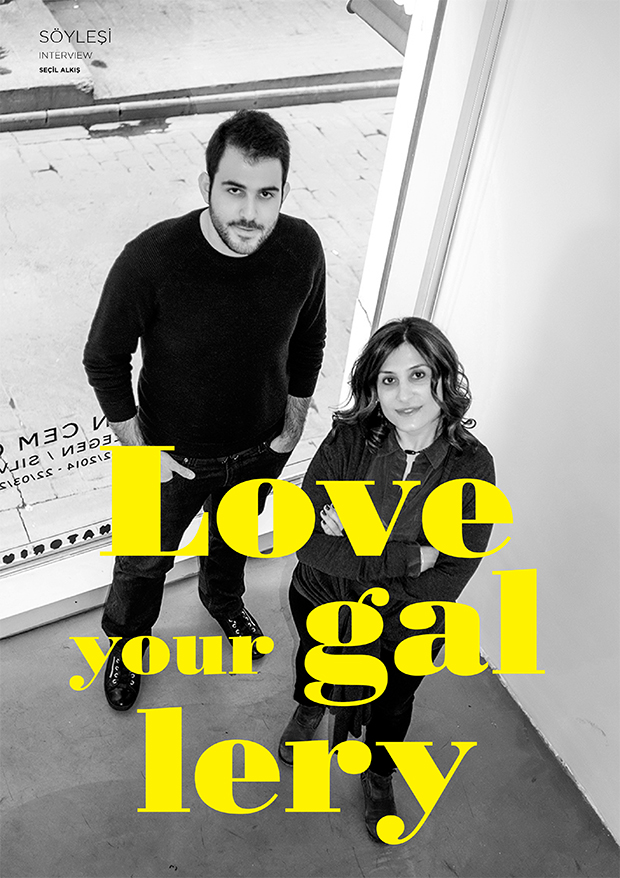

W: Gallery space is a meeting point for artists, artworks, exhibitions, viewers and art professionals. Can you tell us about the location and the gallery space of Sanatorium?
Feza Velicangil: We love our gallery space. We’re aware that there are some problems; but still, when we compare its advantages to its disadvantages, we feel lucky. The location of the gallery is really good; people can find it easily. Thanks to our display window, we can attract the attention of people walking by. The fact that the exhibition space is divided into two floors makes its possible for us to make two simultaneous solo exhibitions. Artists usually like the scale and the indented shape of the gallery. Though the exhibition space is really important, it’s the office where we spend all our time. We tried to make the office as comfortable as possible. And I think we have succeeded, as it turned into a space in which we can have long conversations and establish contact with artists, viewers, collectors and people from the art scene.
S.A.: Sanatorium is one of the prominent galleries with its fitting and characteristic attitude in selecting the artists it works with. What is your approach?
F.V.: We’re a little curious. Regardless of whether we work together with them or not, we like to meet all artists, see their works. This surely widens our perspectives. We try to provide as much support as possible to our artists with their artistic development. We try to keep sharing, keep in contact. The rest develops naturally.

W: Normally artists are asked about how they think a gallerist should be. However, how do you think an artist should be?
F.V.: We feel an artist should be a little brave, he shouldn’t be afraid to make mistakes. He should keep working even if he doesn’t share the results with others; and regardless of whatever comes out of the creative process, he should not give up. It’s highly likely that the mistakes of today can turn into a basis for future works. The greatest problem for young artists is economic issues. Our advice to them would be: we know that it’s difficult, but you should have realistic expectations.
W: As a gallerist you face the conflicts between the ethical and the aesthetic, the commercial and the managerial fields of art. How do you balance it?
F.V.: As a gallery, we’re a commercial institution. From the beginning we decided to be on the commercial side of the art scene. From time to time, we make exhibitions, in which there are works that we know will be hard to sell under the current conditions in Turkey. Our intention isn’t to create a balance between art-commerce, nor for redemption. This is a continuous process and our ultimate goal is that, every kind of work we exhibit –whether it’s conceptual art, a video or an installation– should be able to sell. We think that every time we push boundaries, we make small differences in the perceptions of art viewers and collectors.
W: How can new galleries come up with alternatives to the relationship networks of older and settled art dealers?
F.V.: We actually don’t know much about the relationships of settled and older galleries. Every person or institution would have different experiences. As a young gallery, we’ve set up our own network of connections according to the characteristics of Sanatorium and we’re expanding it. But it doesn’t comprise just collectors. This network continues to grow; it consists of artists, collectors, friends from academic institutions, viewers and of course our staff.

W: How is your relationship with the gallery you’re working with?
Erol Eskici: The artists who played a role in the foundation of Sanatorium were close friends of mine, therefore we had a long-term relationship. We have established a similar friendship with Mrs Velicanlıgil as well. When I compare it to my relationships with the previous galleries I worked with, I can say that our relationship is much more transparent and democratic as a result of many factors such as us having known each other for a long time, the fact that there’s not a significant age difference between us, and that we’re open. It’s beneficial to think of a gallery as a form of function and a collection of relationships with its gallerist and artists and all staff, rather than as a vague and abstract institution.
W: What’s your mutual perspective and plans for the future with the gallery?
Erol Eskici: We learn together and we try to solve problems together. Everybody has a lot to learn. One should be tolerant and take responsibility. I find out about my share of responsibility and try to carry it. Sanatorium is a young gallery and I enjoy taking part in structures, together with which I feel that I’m progressing and developing. I think that I should continue with this kind of attitude and try a bit hard.


W: How is your relationship with the gallery you’re working with?
Yağız Özgen: I’m working with a quite young gallery and I don’t have any experience with any other gallery. My only expectation from the gallery is that we work together for a good presentation of my artistic production. It is of course the artist who makes all the decisions, but it’s impossible for the artist to do everything. I for myself think that I witnessed this kind of effort and intention while working with Sanatorium. It’s beyond merely effort and intention, we accomplish many things. The fact that Sanatorium is a gallery with initiative-roots plays an important role in that. It’s a blessing to be able to work with a gallery, which can look at things from the artist’s perspective when at the same time working at a commercial level. In other words, I’m working with a gallery that knows how complex the process of creating something or attempting it, is. It’s quite important for the artist to be able to comfortably let the gallery deal with things concerning his presentation.
W: What’s your mutual perspective and plans for the future with the gallery?
Yağız Özgen: To create, to be more active, to try hard, to do something. Just like what Beuys had said to his students: go and create something. Act. I wasn’t his student, but this doesn’t prevent me from agreeing with him and following his advice. I have no plans other than being active and taking part in activities. As for the gallery, they must plan to do what they can in order to make this process as visible as necessary and then act accordingly.

